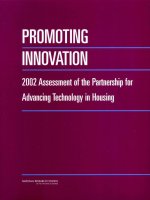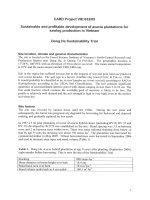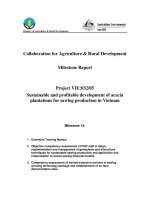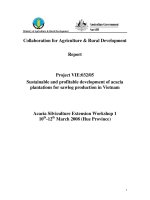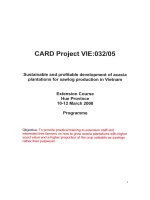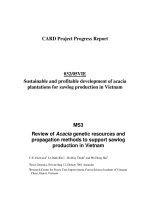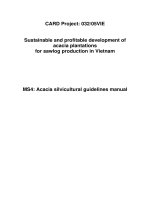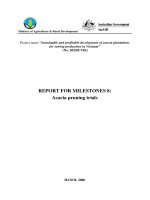Project Progress Report: " Sustainable and profitable development of acacia plantations for sawlog production in Vietnam " pdf
Bạn đang xem bản rút gọn của tài liệu. Xem và tải ngay bản đầy đủ của tài liệu tại đây (4.41 MB, 18 trang )
1
Ministry of Agriculture & Rural Development
Collaboration for Agriculture & Rural Development
Report
Project VIE:032/05
Sustainable and profitable development of acacia
plantations for sawlog production in Vietnam
Acacia Silviculture Extension Workshop 1
10
th
-12
th
March 2008 (Hue Province)
2
List of Participants
The participants were invited by the Hue Provincial Forestry Office. Twenty-five
participants attended the course. They included extension officers, forestry personnel (public
and private), and sawmill employees. All the participants were male.
Name Organisation
NGUYEN HUU HUY Forest Service Department of Thua Thien Hue
NGUYEN DUC HUY Forest Service Department of Thua Thien Hue
VUONG QUANG
HOANG Management Board of Sandy Forest
TRAN VAN NGOC HUY Management Board of Sandy Forest
HOANG PHUOC TOAN Management Board of JBIC Project
HUYNH TU Management Board of Bo River
VAN TIEN HUNG Management Board of Huong River
NGUYEN THANH Management Board of A Luoi Protection Plantations
VO LONG QUAN Forest Product Company
TRAN QUANG PHU 1-5 Joint Stock Company
NGUYEN THAI DUY 1-5 Joint Stock Company
HOANG HUU BANG 1-5 Joint Stock Company
TRAN VAN MINH Management Board of North-Hai Van Protection Plantations
VO HUU SANG Management Board of Nan Dong Protection Plantations
NGUYEN VAN LUYEN Management Board of Huong Thuy Protec Plantations
NGUYEN QUANG
THUONG Chaiyo Company
PHAN VAN HUYNH Thua Thien Hue Centre for Agriculture and Forest Extension
HO GAP Thua Thien Hue Centre for Agriculture and Forest Extension
PHAM CANH Phu Loc Forest Company
LE DINH Truc Thu Forest company
NGO HOANG HAI Tien Phong Forest Company
PHAM HO HAI LONG Huong Giang Wood Processing Company
LE PHAN Huong Giang Wood Processing Company
LE VAN THIEN Phong Dien Forest Company
NGUYEN XUAN DINH Quang Tri Centre for Agriculture and Forest extention
Programme
The Extension Workshop was conducted over a three-day period from 10
th
-12
th
March. The
full programme is summarised in Appendix 1. There are four other Appendices: Appendix 2
contains the Course Notes; Appendices 3 and 4 contain notes that refer to the silvicultural
trials established at Dong Ha and Dong Hoi. These appendices were translated into
Vietnamese. Appendices 5 contains notes that refer to the seed orchards and tree
improvement trials established at Dong Ha (available in Vietnamese only). These
Appendices were circulated to participants at the start of the course.
3
Day 1. Monday 10
th
March. Hue and around Hue
The two FSIV (Mr Phi Hong Hai and Mr Dang Thinh Trieu) and one CSIRO (Dr Chris
Beadle) staff delivering the course were welcomed at the Hue Forestry Office by Mr Chi Cuc
Truong, the Director of the Hue Provincial Forestry Service.
The participants were formally welcomed by Mr Le Van Hoa, the Deputy Director (Plate 1).
Chris Beadle also welcomed them on behalf of the Vietnamese and Australian staff working
on the CARD project.
The morning programme consisted of four activities, the afternoon one activity. Two of the
morning activities were at demonstration sites (Stands 1 and 2) that had first been prepared in
November 2006 for the purposes of this Extension Workshop. Additional work was done on
these sites in the intervening period. They are part of a network of four CARD
demonstration sites close to Hue city (Table 1). A third, 10-month-old stand (Stand 3) was
also used for the workshop. The fourth morning activity was at a small sawmill owned by
Mr Nguyen Bo. The afternoon activity was at a large integrated sawmill and furniture-
making company (Huong Giang [Perfume River] Wood Processing Company).
Stand 3: Form pruning (Mr Trieu)
This stand was located about 400 m from Stand 2 and was age 10 months old. It was
selected the day before the course and used to demonstrate:
• Tools that can be used for pruning: saws, shears, secateurs;
• Essential rules when pruning branches:
o Live branches;
o Excise at edge of root collar (role of root collar in occlusion of branches);
o Avoid all damage to bark; undercutting large branches before pruning can eliminate
bark tearing.
• Selecting branches for form pruning;
• When to use tip pruning and how to apply it.
The participants then spent 30 minutes practising form pruning and familiarising themselves
with the use of the various tools (Plates 2-4).
Stand 2: Singling and 1
st
-lift pruning (Mr Trieu)
• Singling and the consequences of not singling (demonstrated at this stand) (Plate 5);
• 1
st
-lift pruning to 2 m height (Plate 6).
The participants then spent 30 minutes practising 1
st
-lift pruning.
Stand 1: 2
nd
-lift pruning, tree size and basal area. Pruning and wood quality (Mr Trieu)
• 2
nd
-lift pruning to 4 m height;
• The relationship between stand density, tree size and basal area;
• Decay entry, knotty and knot-free (clear) wood.
4
Table 1: List of demonstration trials in Hue Province, Central Vietnam. The maximum
diameter at breast height was estimated on 10
th
March 2008
Site 1 Site 2 (Stand 1*) Site 3 Site 4 (Stand 2*)
Location Thuy Phu,
Huong Tra, 20
km S of Hue
Huong Tho,
Huong Tra, 12
km W of Hue
Phu Bai, Huong
Thuy, 25 km S
of Hue
Huong Tho,
Huong Tra, 12
km W of Hue
Species Acacia hybrid Acacia hybrid Acacia hybrid Acacia hybrid
Area 0.2 ha 0.2 ha 0.2 ha 0.2 ha
Date planted Dec 2004 Dec 2004 Oct 2005
Spacing
3 m × 2.5 m
#
3 m × 2.5 m 3 m × 3 m
Rotation 1R 1R 2R
Previous
vegetation
Pinus merkusii Pinus merkusii A. mangium
Soil type Granite Granite Granite
Fertiliser at
planting
100 g 10:10:5
NPK in hole
100 g 10:10:5
NPK in hole
100 g 10:10:5
NPK in hole
Maximum
diameter at 1.3
m
8-9 cm 6.5-7.5 cm
Singling
Form pruning
1
st
-lift pruning
2
nd
-lift pruning
Sept 2006 No
No
Nov 2006 to 2-2.5
m
Nov 2007 to 4 m
No
No
Nov 2006 to
2.0- 2.5 m
Nov 2006
Demonstrated
Mar 2008 to 2.0
m
Ownership Forest
Enterprise
Forest Enterprise Forest
Enterprise
Forest Enterprise
Other
comments
Weeded
Less fertile –
may be water
stress
Weeded
*Stands 1 and 2 as referred to in the Extension Course
#
Stocking currently 1000-1200 stems ha
-1
5
Plate 1: Mr Le Van Hoa, the Deputy Director Hue Provincial Forestry Service welcoming
participants to the Extension Course. Plate 2: Mr Trieu demonstrates the tools that can be
used for pruning at Stand 3. Plate 3: A participant practises pruning a large branch with a
saw at Stand 3. Plate 4: Mr Trieu explains how to select branches for form pruning at Stand
3. Plate 5: Participants examine the consequences of not singling at Stand 2. Plate 6: A
participant practises lift pruning with shears at Stand 2.
General Discussion
The participants made the following points during the discussion (Plate 7):
• What they had seen was a convincing demonstration of improved practice;
• Most of the participants oversee plantations that receive slash pruning and unstructured
thinning;
• For many it was the first time they had seen pruning shears;
• It is difficult to purchase the right tools;
• Wood quality is not a variable that gets considered;
• Pruned stems do not attract a price premium;
• Demonstration trials are required throughout the province to convince farmers that
improved practices can deliver benefits. It was unclear how this could be resourced.
6
Plate 7: A participant discusses the management of pruned stands at Stand 1. Plate 8: Mr
Trieu explains the sawmill system at Mr Nguyen Bo’s small sawmill.
Mr Nguyen Bo’s small sawmill (Mr Bo was unable to be present) (Mr Trieu)
• Log sizes processed and prices paid at this mill;
• The sawmill system (Plate 8);
• Variation in log quality.
Perfume River Wood Processing Company (company staff) (Plates 9, 10)
Mr Hiep, the Director welcomed the participants and outlined the main features of the mill.
• Mr Long (a participant on the course) and Mr Phau showed us round;
• Operating for five years, turnover $700,000, 300 employees, export only (mainly to
France);
• Log purchasing (mainly acacia hybrid and A. mangium) highly competitive (the company
owns 100 ha plantation);
• 4000 m
3
throughput; average price paid 1.2M Dong m
-3
; log size must be 12 cm diameter
minimum in the centre;
• Break-even recovery of sawn timber was 58%;
• “Brittleheart” more prevalent in A. mangium than acacia hybrid. A. mangium cut to
thinner boards;
• Oven-drying at 50 ºC for 16 days; powered by waste wood (shavings etc).
The participants were able to see all aspects of the operation: rough sawing, drying,
measuring and cutting piece sizes; final shaping, planing and form work; drilling, assembly
and finishing.
7
Plate 9: Participants observe a mill employee using a template to maximise the recovery of
wood for furniture parts. Plate 10: Participants examine the assembly of components for the
export outdoor furniture market (mainly to France).
Day 2. Tuesday 11
th
March. Dong Ha
Dong Ha FSIV station is a major centre in Vietnam for tree improvement experiments.
These were the main feature of the second day programme. The other activity was a visit to
a sustainability trial that has just been established as part of the CARD project.
Acacia mangium and A. auriculiformis seed production areas (SPAs) (Mr Hai/Mr Dinh)
• Yield is 20-30 kg seed per 2-3 ha of the SPA;
• Vietnam is very short of acacia seed; currently importing large quantities from Australia;
interestingly, Australian seed is often preferred by growers even though the Vietnamese
improved seed is superior;
• Flowering of A. auriculiformis generally poor;
• Ten per cent is hybrid seed but this cannot be recognised;
• The widespread use of unimproved seed was discussed. There was a lack of
understanding amongst growers of the availability and advantages of improved stock.
Acacia auriculiformis genetic gain trial (Mr Hai)
• The real genetic gain in stem volume at age four years is 38% for seedling seed orchard
elite seed and 32% for seed production area elite seed, relative to natural provenance seed;
• The worst performing stock was that raised from a Vietnamese commercial seed source,
with 41% lower stem volume than the natural provenance seed at age four years (related
to inbreeding and selection of trees with poor form in the commercial seed production
areas);
• Select seedling seed orchard seed had the best rates of growth at age four years and
significant improvements in form (forking and stem straightness, characteristics essential
for sawlog production) (Plate 11).
Acacia mangium genetic gain trial (includes A. hybrid clones) (Mr Hai)
• A. mangium growing faster than A. hybrid on this site at age 5 years;
• A. mangium is more wind stable than A. hybrid;
• Seedling seed orchard seed is also the best performing at this site;
• On high rainfall sites (>2000 mm), A. hybrid is more susceptible to disease.
8
Acacia crassicarpa Seedling Seed Orchard (Mr Hai)
• There are fundamental problems getting this species to set seed. This may be linked to
flowering occurring during the rainy season though the true nature of the problem is not
resolved;
• Because of these problems, at least 150 of the top families in this SSO will be grafted.
This is being done so that more seed orchards of A. crassicarpa can be established in
Vietnam.
• The first intention is to establishing another SSO in Hue province. A suitable site is being
sought.
Plate 11: Mr Hai explains the benefits to be gained from using selected seed orchard seed at
the A. auriculiformis genetic gain trial at Dong Ha. Plate 12: Mr Trieu describes the
treatments that are being used in the new CARD Sustainability Trial that was established in
December 2007 at Dong Ha.
Sustainability trial (Mr Trieu)
• The trial was planted in early December 2007 (Plate 12). Since planting it has been very
cold and there has not been much growth (<20 cm with some tops being lost). Survival at
age three months was generally >90% but in patches no better than 80%. Replanting is in
progress.
• The ramets were inserted into planting holes that had been prepared in the following way:
o A 40 × 40 × 40 cm volume of soil was dug from the ground. The bottom 15 – 20
cm was returned and the measured amount of fertiliser added and mixed thoroughly
in this layer. It was then covered by about a 5 cm layer of soil. This isolates the
planted ramet from direct contact with the fertiliser. The ramet is planted in the top
15 cm of soil.
o The large planting hole may be advantageous for root development, and for wider
distribution of the fertiliser. It may also be useful for capturing and storing more
water around the ramet at dry sites, as at Dong Ha.
• The levels of P applied were equivalent to 16 and 32 kg ha
-1
.
• No pre-planting weed control was undertaken because there were no weeds present.
There is now a broad weed spectrum that includes a lot of shrubby species. (Mr Huong
indicated later that these would be slashed before glyphosate was applied: glyphosate is
ineffective against mature shrubby vegetation but should control resprouting young leaves
after slashing.)
9
General Discussion
The participants raised the following issues during the discussion:
• The relative benefits of burning v. slash retention, including how each affects nutrient
supply;
• The effects of burning on regeneration of acacia wildings;
• Chemical v. manual weed control and the environment;
• The potential for fertiliser at planting to kill seedlings.
Day 3. Wednesday 12
th
March. Dong Hoi
The primary content of the morning programme was a visit to a thinning trial established in
June 2006 by the CARD Project (Plates 13, 14). Significant responses to thinning were
observed 12 months after thinning. This is one of the best examples in Vietnam of an Acacia
plantation containing trees of quite uniform size and high levels of stem straightness. The
subjects covered are detailed in the programme (Appendix 2).
Plate 13: Mr Trieu teaches participants the rules that must be followed when thinning stands
in the Block 1 600 stems ha
-1
treatment at the CARD Thinning Trial in Dong Hoi. Plate 14:
Course participants in the Block 2 300 stems ha
-1
treatment at the CARD Thinning Trial in
Dong Hoi. Plate 15: Pinus merkusii (foreground) and Pinus caribea (background) of the
same age in a tree improvement trial at Dong Hoi. Plate 16: A collar rot attacking and killing
P. caribea in the Dong Hoi trial.
10
General Discussion
The participants made the following points during the discussion:
• Thinning strategy was an important consideration for ensuring that tree growth rates and
size were managed for the required end product;
• Thinning intensity may have effects on stem shape;
• A standard system was required for scoring stem shape (a system for scoring form was
presented as part of the Extension Course notes (Appendix 2).
• Stocking up to 4000 stems ha
-1
which often occurs in Vietnam is not necessary (the
correct stocking at establishment remains uncertain but should probably be between 1000
[4 m × 2 m] and 1667 [3 m × 2 m] stems ha
-1
)
A second activity was a short visit to an area used for tree improvement trials:
• Eucalypt hybrid trial – various hybrid combinations are being tested;
• Pinus caribea and Pinus merkusii trials:
o Growth rates of P. caribea far exceed those of P. merkusii (the latter grown for high
resin content) (Plate 15);
o P. caribea quite severely affected by collar rot leading to eventual tree death (Plate
16).
Conclusion
Mr Long (Perfume River Wood processing Company), one of the participants gave a vote of
thanks on their behalf. He said that the main value had been in the large amount of new
information that had been introduced to them and discussed. He was aware that some of the
participants were now ready to go back to plantations for which they were responsible and
start testing some of the techniques that they had learnt.
Dr Chris, Mr Hai and Mr Trieu then thanked the participants for their attention and
willingness to participate in an open discussion of the subjects covered during the course. It
was hoped that contact could be maintained in the future so that new information could be
sent to them when it became available. Mr Hai encouraged them to approach FSIV if they
had particular questions that they wanted to raise.
Comment
Mr Huy, a professional forester at the Provincial Forestry Service in Hue was asked to
comment on the course content. He indicated that the course materials had been fine for this
audience as it was made up entirely of participants with at least some professional training in
an aspect of forestry. If farmers had been the audience it would have been difficult for them
to understand a lot of the information. He suggested the production of simple visual aids that
could be used to illustrate the main points that we wanted to impart to participants when they
were being spoken to in the field.
